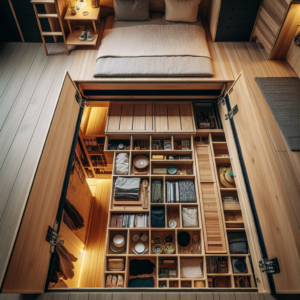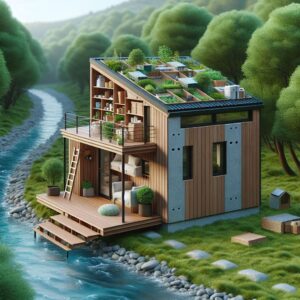Key Takeaways
-
Utilize vertical space in tiny homes with smart loft storage solutions.
-
Choose eco-friendly materials to minimize environmental impact.
-
Incorporate built-in shelving and cabinets for efficient organization.
-
Embrace dual-purpose furniture for added functionality.
-
DIY projects can enhance storage space and personalize your tiny home.
Space-Elevating Strategies for Lilliputian Living
When living in a tiny home, every inch counts. That’s why looking up and leveraging the vertical space is a game-changer. It’s not just about saving space; it’s about creating an environment that’s both functional and comfortable. And when you do it in an eco-friendly way, you’re not just maximizing your living area, you’re also taking care of our planet.

Loft Storage: Smart, Sustainable, Space-Saving
Imagine transforming your loft into a clutter-free zone where everything has its place. Loft storage is not just a clever way to hide away your belongings, it’s a strategic approach to design that enhances the entire living experience. By using materials that are kind to the environment, you’re making a responsible choice that feels good every time you reach for that neatly stored item.
Creative Stacking: How Vertical Storage Amplifies Tiny Home Functionality
Vertical storage is not just about shelves. It’s about rethinking how we store our possessions in a way that aligns with the tiny home philosophy. It’s about choosing furniture that doubles as storage, using hooks and racks to hang items, and finding innovative ways to use every available space. It’s creative, it’s efficient, and most importantly, it’s incredibly effective.
Blueprint for Lofty Aspirations
Structural Soundness: Securing Your Vertical Space
Before we dive into the aesthetics, let’s talk safety. Your loft storage needs to be secure. That means ensuring that the structures you choose to install are capable of holding the weight of your stored items. This might involve reinforcing your loft’s flooring or choosing shelving that’s designed to be anchored to the walls.
Think about what you’ll be storing up high. Heavy items need sturdy shelves. If you’re storing books, for instance, a bookshelf with a solid back and brackets is non-negotiable. For lighter items, hanging mesh or fabric storage solutions might be just the ticket.
Eco-Friendly Materials: Picking Sustainable Options
Now, let’s talk materials. Eco-friendly doesn’t just mean recyclable. It means materials that have a low impact on the environment from production to disposal. Think bamboo or reclaimed wood for shelving, and recycled metal for brackets and supports. When you choose these materials, you’re not just getting storage solutions that are durable and stylish, you’re also making a statement about the values that guide your life.
Here are some materials to consider for your eco-friendly loft storage:
-
Bamboo: Fast-growing and sustainable, bamboo is a great choice for shelving.
-
Reclaimed wood: Using reclaimed wood not only gives your tiny home character, it also prevents the need for new timber.
-
Recycled metal: Metal brackets made from recycled materials offer strength and durability.
Revolutionizing the way we approach storage in our cozy lofts can be a delightful challenge. With the right strategies, our tiny homes can not only become exemplars of space efficiency but also bastions of sustainability.
Integrated Shelving Units
Integrated shelving units are the secret weapon in the tiny home owner’s arsenal. By building shelves directly into the structure of your loft, you minimize the need for additional furniture and make the most of every square inch. Opt for materials like reclaimed wood for a rustic look or metal for a modern vibe. And remember, the closer the shelves are to the wall, the more spacious your loft will feel.
Custom Cabinetry
Custom cabinetry is the next level of storage sophistication. Tailored to fit the unique dimensions of your tiny home’s loft, cabinets can hide away linens, clothing, and more, keeping your space serene and streamlined. Consider using eco-friendly paints and finishes to maintain a low environmental impact.
Imagine a loft where the walls are lined with cabinetry crafted from reclaimed barn wood. Each cabinet door swings open to reveal a bounty of neatly organized belongings, all within arm’s reach but out of sight when not in use.
Moving beyond shelves and cabinets, let’s explore the vertical potential of your loft walls.
Rethinking Racks and Hooks: Versatile Hanging Solutions
Walls are often underutilized in tiny home design. By introducing adjustable wall racks and folding hooks, you can hang everything from kitchen utensils to bicycles, making the most of your vertical space.
Adjustable Wall Racks
Adjustable wall racks are a flexible solution for changing storage needs. With a variety of attachments and configurations, these racks can hold a range of items securely. Plus, they’re easy to install and can be moved as your needs evolve.
Folding Hooks and Hangers
Folding hooks and hangers are perfect for temporary storage needs. Use them to hang coats, bags, or even chairs when they’re not in use. When you need to free up space, simply fold them away against the wall.
Functional Finesse: Smart Organizing Tips
Smart organizing is about making every choice count. It’s about selecting furniture that serves more than one purpose and containers that not only store but also conceal.
Furniture with a Flip: Dual-Purpose Design
Dual-purpose furniture is a cornerstone of tiny home living. Think of a bench that opens up to reveal shoe storage, or a bed frame with built-in drawers. These pieces allow you to live comfortably while keeping your belongings neatly tucked away.
Contain, Conceal, Clutter-Free: Bins and Baskets
When it comes to maintaining a clutter-free loft, bins and baskets are your best friends. They can be tucked into shelves or cabinets, and come in a variety of materials, including woven natural fibers, which add texture and warmth to your space.
Up in the Air: Final Ruminations on Loft Storage Innovation
As we near the end of our exploration into maximizing vertical space in tiny homes, it’s important to reflect on the journey we’ve taken. We’ve considered the practicalities of structural soundness, the environmental impact of our material choices, and the clever design of integrated storage solutions. We’ve envisioned the transformative power of racks, hooks, and dual-purpose furniture. And we’ve dipped our toes into the world of DIY, empowering ourselves to take control of our tiny home’s destiny.
But the innovation doesn’t stop here. The beauty of tiny home living is that it is a continuous adventure in creativity and ingenuity. As new materials become available and our skills improve, our loft storage solutions will evolve, always with an eye toward sustainability and maximizing our precious space. The loft is not just a place to store our things—it’s a symbol of our ability to rise above the clutter and chaos, to live in harmony with our environment, and to make the most of every square foot we call home.
FAQs: All About Eco-Friendly Loft Storage in Tiny Homes
You’ve got questions, and I’ve got answers. Let’s dive into some of the most common queries about eco-friendly loft storage in tiny homes. Whether you’re just starting your tiny home journey or looking to upgrade your current setup, these insights will help you make informed decisions about your vertical space.
How can I ensure my loft storage is eco-friendly?
To ensure your loft storage is eco-friendly, focus on materials and processes that have minimal environmental impact. Choose reclaimed wood, bamboo, or recycled metal for your shelving and supports. Look for non-toxic finishes and adhesives. And always consider the full lifecycle of the products you’re using—from production to disposal, aim for sustainability.
What are the best materials for DIY loft storage projects?
When it comes to DIY loft storage projects, the best materials are those that balance durability with eco-friendliness. Here are a few options:
-
Reclaimed wood is not only sturdy but also adds character and history to your home.
-
Bamboo is a renewable resource that’s both lightweight and strong.
-
Recycled metal can be fashioned into durable brackets and supports.
Always research the source of your materials to ensure they align with your environmental values.
Can loft storage solutions be visually appealing and still practical?
Absolutely! Loft storage solutions can enhance the aesthetic of your tiny home while serving a functional purpose. Open shelving can display decorative items alongside your neatly organized essentials. Custom cabinetry can be crafted to complement your home’s design. The key is to blend form and function—choose storage options that are both beautiful and serve your organizational needs.
How can I make my loft storage easily accessible?
Ease of access is crucial in loft storage design. Consider these tips:
-
Install a sturdy ladder or steps that blend seamlessly with your home’s style.
-
Arrange items you use frequently within easy reach and less-used items higher up.
-
Use sliding or pull-down mechanisms for high shelves to bring items to your level.
Remember, the goal is to create a space that works for you, not against you.
Is it possible to incorporate loft storage in a rental tiny home?
Incorporating loft storage in a rental tiny home can be a bit more challenging, but it’s certainly possible. Look for non-permanent solutions like freestanding shelving units or tension rods with hanging baskets. Always communicate with your landlord before making any modifications. With a little creativity, you can enhance your rental’s storage capacity without leaving a lasting mark.





